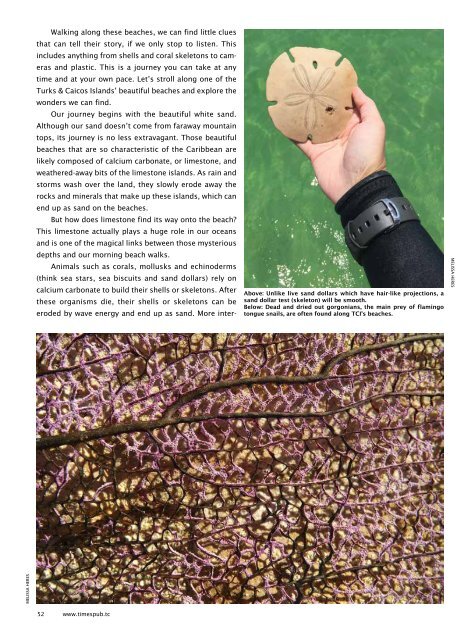Times of the Islands Spring 2021
Presents the "soul of the Turks & Caicos Islands" with in-depth features about local people, culture, history, environment, real estate, businesses, resorts, restaurants and activities.
Presents the "soul of the Turks & Caicos Islands" with in-depth features about local people, culture, history, environment, real estate, businesses, resorts, restaurants and activities.
You also want an ePaper? Increase the reach of your titles
YUMPU automatically turns print PDFs into web optimized ePapers that Google loves.
Walking along <strong>the</strong>se beaches, we can find little clues<br />
that can tell <strong>the</strong>ir story, if we only stop to listen. This<br />
includes anything from shells and coral skeletons to cameras<br />
and plastic. This is a journey you can take at any<br />
time and at your own pace. Let’s stroll along one <strong>of</strong> <strong>the</strong><br />
Turks & Caicos <strong>Islands</strong>’ beautiful beaches and explore <strong>the</strong><br />
wonders we can find.<br />
Our journey begins with <strong>the</strong> beautiful white sand.<br />
Although our sand doesn’t come from faraway mountain<br />
tops, its journey is no less extravagant. Those beautiful<br />
beaches that are so characteristic <strong>of</strong> <strong>the</strong> Caribbean are<br />
likely composed <strong>of</strong> calcium carbonate, or limestone, and<br />
wea<strong>the</strong>red-away bits <strong>of</strong> <strong>the</strong> limestone islands. As rain and<br />
storms wash over <strong>the</strong> land, <strong>the</strong>y slowly erode away <strong>the</strong><br />
rocks and minerals that make up <strong>the</strong>se islands, which can<br />
end up as sand on <strong>the</strong> beaches.<br />
But how does limestone find its way onto <strong>the</strong> beach?<br />
This limestone actually plays a huge role in our oceans<br />
and is one <strong>of</strong> <strong>the</strong> magical links between those mysterious<br />
depths and our morning beach walks.<br />
Animals such as corals, mollusks and echinoderms<br />
(think sea stars, sea biscuits and sand dollars) rely on<br />
calcium carbonate to build <strong>the</strong>ir shells or skeletons. After<br />
<strong>the</strong>se organisms die, <strong>the</strong>ir shells or skeletons can be<br />
eroded by wave energy and end up as sand. More inter-<br />
Above: Unlike live sand dollars which have hair-like projections, a<br />
sand dollar test (skeleton) will be smooth.<br />
Below: Dead and dried out gorgonians, <strong>the</strong> main prey <strong>of</strong> flamingo<br />
tongue snails, are <strong>of</strong>ten found along TCI’s beaches.<br />
MELISSA HERES<br />
MELISSA HERES<br />
52 www.timespub.tc

















